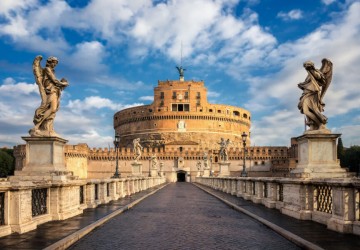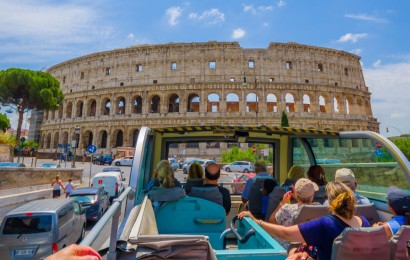Castel Sant'Angelo (also called Mausoleum of Hadrian) is a monument of Rome located near the Vatican and more precisely along the right bank of the Tiber. A state-owned fortress of the Italian State connected to the Vatican State through the fortified corridor of the "passetto".
You can reach Castel Sant'Angelo from stop 6 "Città del Vaticano" of our Hop On Hop Off tour. Or enjoy a guided tour of the historic center of Rome and admire its most famous monuments such as the Trevi Fountain, the Palazzo di Montecitorio, the Pantheon, and even Castel Sant'Angelo.
The museum of Castel Sant'Angelo
The history of Castel Sant'Angelo has made the monument a real museum, which houses numerous collections, becoming a museum in 1925 and hosting various collections of sculptures, paintings, marble finds, weapons, furniture and objects of various origins. Inside is even preserved a circular stone with carved footprints that would have been left by the Archangel Michael during the celestial ascension.
The structure of the museum is developed on seven levels attributable to three different architectural types, and that well explain the various modifications that have affected the monument. Enrich your experience in the eternal city, and take advantage of the proximity with our Hop-On Hop-Off stop, completely immersing you in the visit of Castel Sant'Angelo. Defensive fortress, prison, castle and noble residence, apostolic see, refuge of the Popes, barracks and finally, museum. Today owned by Mibact and since 2014, part of the Polo Museale del Lazio.
History of Castel Sant’Angelo
The history of Castel Sant'Angelo dates back to 135 A.D. when Emperor Hadrian ordered the construction of a huge funeral mausoleum for himself and his family. The Castle held its function until 403 A.D. when it was connected to the Aurelian Wall at the behest of the Western Emperor Honorius.
From that moment he lost the original function of sepulchre and began a second life as castellum, an advanced bulwark beyond the Tiber to defend the city of Rome. Infattì will be the fortification to save the Vatican settlement first by the Visigoth Sack of Alaric in 410 A.D. and then by the Vandals of Genserico in 455 A.D.
At the beginning of the 6th century the castle was used as a state prison by Theodoric.
According to tradition, it was in 590 A.D. that the monument got its current name. It is said that Pope Gregory I decided to organize a solemn penitential procession because of the serious plague that had struck Rome. During the procession, while he was crossing Helium Bridge, he had the vision (on the top of the Mole Adriana) of the archangel Michael who sheathed his sword as if to signify the end of the plague.
From that moment the Castle took the name of Castel Sant'Angelo. The possession of the building was later disputed between numerous families: it became the stronghold of Senator Teofilatto and his family, passed into the hands of the Crescenzi family under the name of Castrum Crescentii, then became the property of the Pierleoni and later the Orsini.
It was with Pope Nicholas III of the Orsini family that, to ensure greater security at the Vatican Palace, the Passetto di Borgo was built: an elevated and fortified passage that connects the Vatican to the Castle.
The fortunes of Castel Sant'Angelo are inseparably linked to those of the pontiffs in 1367, when the keys to the castle were handed over to Pope Urban V, to urge the return to Rome from Avignon’s exile. Its solid and fortified structure will allow it to be used for various functions: as a refuge in times of danger, to house the Vatican Archives and Treasury, as a court and prison.
Castel Sant’Angelo: curiosities to know
Castel Sant'Angelo is one of the most popular destinations in Rome but do you know its particularities?
Here are some curiosities about Castel Sant'Angelo:
- The prisons of the Castle saw pass many famous people including: Giordano Bruno, Alessandro Farnese, Cagliostro (the famous necromancer), and Benvenuto Cellini, famous for his escape (through a latrine) from the cell in which he was locked;
- On the top of Castel Sant'Angelo there is a bronze statue representing the archangel Michael. This statue has a troubled history. It is in fact the sixth statue, followed by a sequence of statues made of different materials such as wood and marble;
- Castel Sant'Angelo has inspired many directors and songwriters. Here Puccini set the last act of his Tosca. Subsequently, Castel Sant'Angelo in Rome was the set of the film Senso (1954) by Luchino Visconti and part of the setting of Dan Brown’s Hollywood colossal "Angels and Demons". He also appears in the video games Assassin’s Creed II and Assassin’s Creed: Brotherhood.
It is also mentioned in the lyrics of some songwriters, as in some of Achille Lauro: "Bvlgari" and "Zucchero"; - Today the bridge of Sant'Angelo is decorated with the statues of San Pietro and San Paolo. These two sculptures were followed by the series of angels commissioned by Pope Clement IX and created by Bernini’s students under his meticulous guidance.
From 1500 onwards, however, on the Bridge were exposed the severed heads of those sentenced to death. Hence the Roman saying "I know more heads cut on the shoulders than melons at the market"; - The executor of the death sentences of the Papal States in 800 was Giovanni Battista Bugatti called "Master Titta Er boja de Roma". Master Titta was not only an executioner but also an umbrella. He lived and worked a few steps from Castel Sant'Angelo, on the right bank of the Tiber, in Via del Campanile 2.
He served 68 years and tormented and executed 516 people by hanging, cleaver or guillotine.

